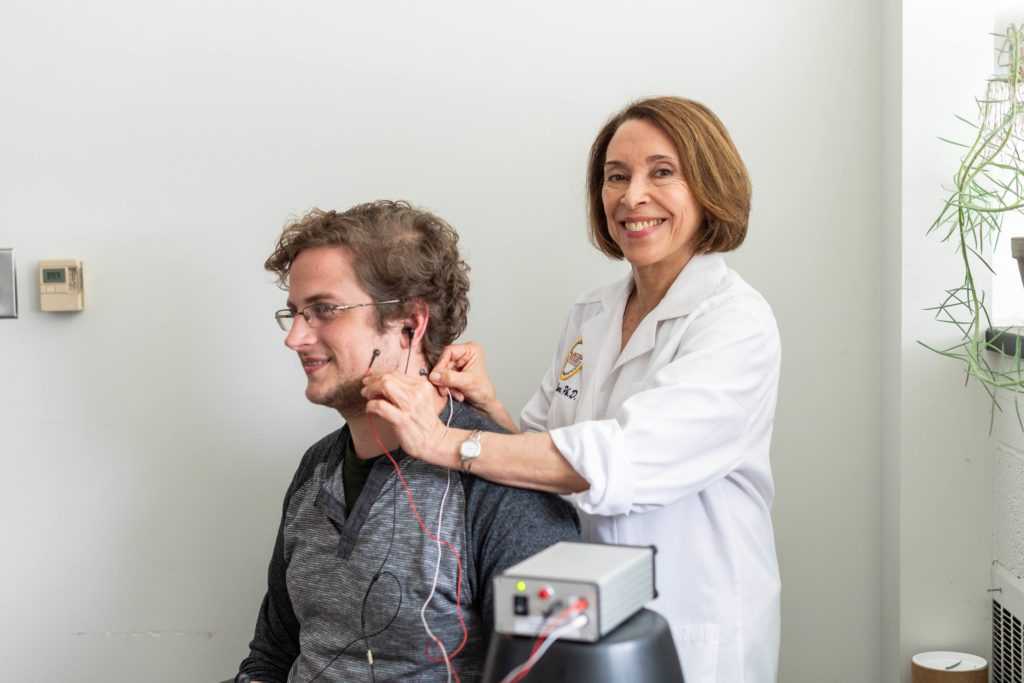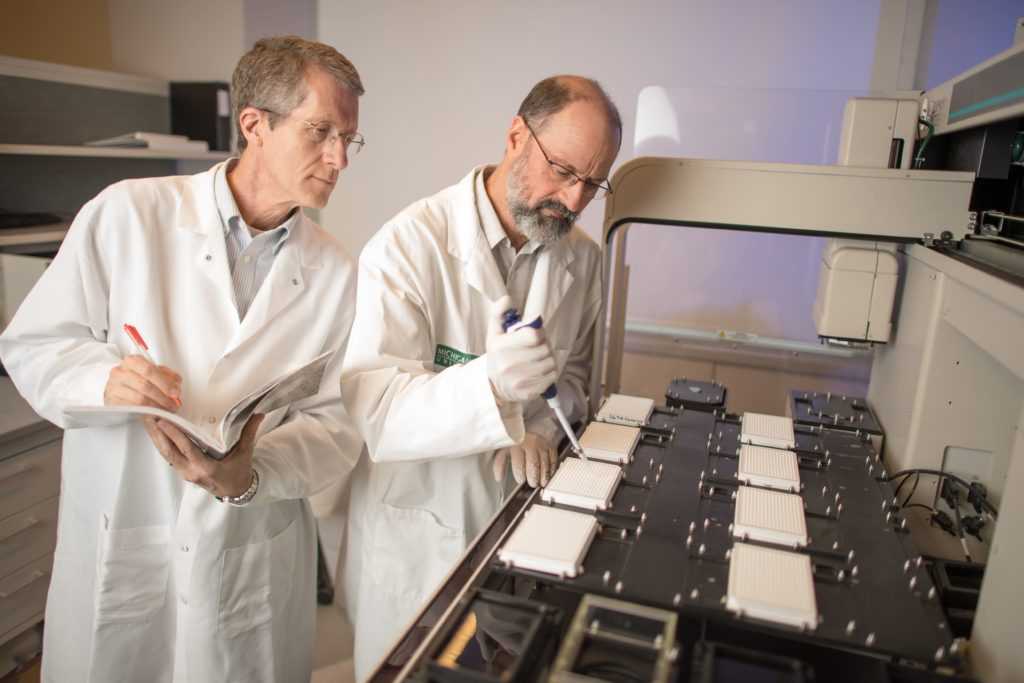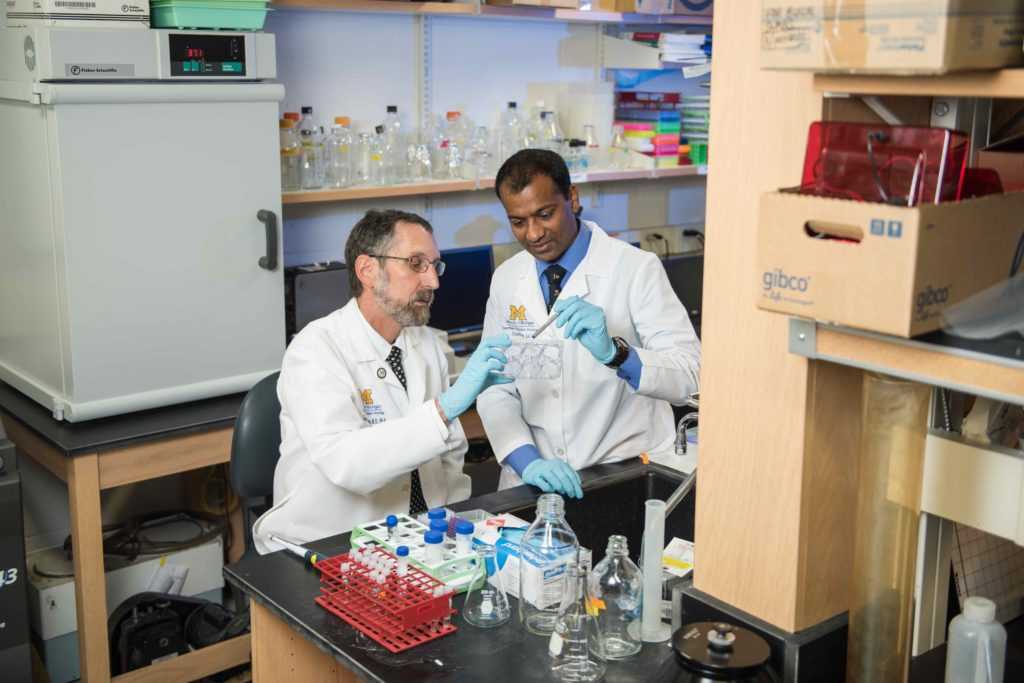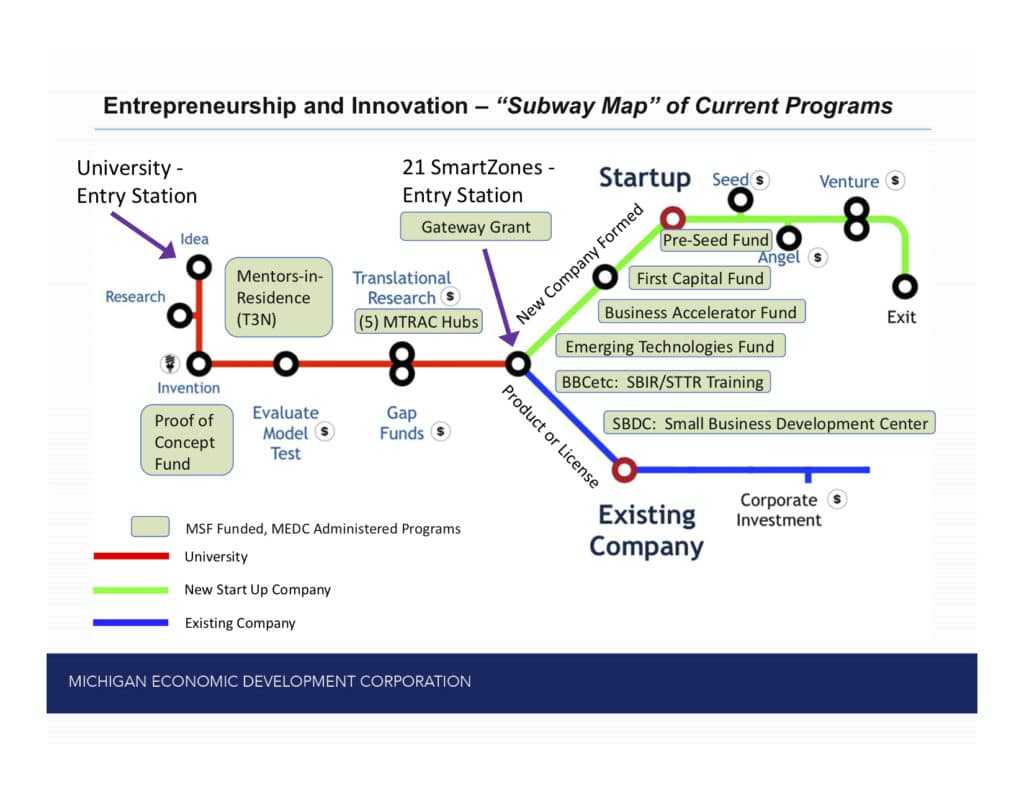MTRAC: How a Michigan Life Science Startup Is Born
By Laura Cowan
Laura K. Cowan is a tech, business, and wellness journalist and fantasy author whose work has focused on promoting sustainability initiatives and helping individuals find a sense of connection with the natural world.
Susan Shore, Ph.D.. Technology aims to remodel neural pathways that cause ringing in ears.
Joe Affholter of Michigan State Unversity and Michelle Larkin at the University of Michigan have essentially the same job: get academic research in the life sciences from the laboratory where it is discovered in Michigan's half dozen largest research universities out to industry. Sounds simple, but it's anything but. That's because the MEDC's Life Sciences MTRAC program is tasked with licensing technology invented in the academic system, mentoring new founders who often did not start in industry, and with helping companies get funded through clinical trials and the push out to the commercial market, which can take years to complete.
That's why the MTRAC program, split into several industries, exists. Without it, life sciences startups spun off from academic research would have a much smaller chance at success. We met with Affholter and Larkin, as well as the MEDC's University Relations Director for Entrepreneurship & Innovation at the Michigan Economic Development Corporation Denise Graves, who supports these programs for the state of Michigan, to dive into how this process really works. We thought tech readers might glean a few ideas for their own startups, or gain a better understanding along with us at Cronicle of how life science startups are born.
How Is A Life Sciences Startup Created?
"We have 4 main categories," says Michigan's Larkin. "Diagnostics, therapeutics, new devices, and digital health platforms." This includes everything from new technology for detecting cancer to software for managing health programs.
What's the difference between the program at the University of Michigan and at Michigan State? "The MTRAC program at MSU is focused on AgBio," Affholter chimes in. "If it touches life and is not human medicine focused, we work on that. That includes animal health, bio materials and feedstocks, as well as addressing diseases that affect the above." Even food packaging and water fall under the MSU program's purview, because they also touch food and human health.
"The MTRAC for Life Sciences program is available to faculty and researchers at research universities," Larkin explains. MTRAC organizes a number of technical mentors to help get a life sciences startup out into the world, from marking milestones for customer discovery and business development to helping founders decide if they want to license technology or take the helm in getting their new tech out into industry as CEO of a new company. "Mentorship centers around commercializing the technology," Larkin says.
Scott Larsen, Ph.D. and Richard Neubig, M.D., Ph.D.. Small-molecule therapeutics for treating scleroderma.
Affholter confirms that these programs are only for academic researchers and faculty. "Faculty are mentored on how to focus on commercial milestones," he says, "and how to figure out which milestones are most impactful." The MSU MTRAC program for AgBio includes mentors from Spartan Innovations and funding from Red Cedar Ventures, all under one roof.
Why is MTRAC the label for so many different programs around the state of Michigan? "The MTRAC program supports 5 innovation hubs," Graves explains. That is why the program sounds so diverse. Even though it's all contained within academia and the somewhat opaque universe of tech startup funding, the MTRAC programs are split into very different tracks including ag bio, life sciences, transportation, computing, and advanced materials. "Industry gets involved to license tech once it's through our program," Graves says. "Venture capital puts milestones on projects," but really, most of the mentorship and milestones are hit within the MTRAC program first, then the startups launch out into wider world where they're treated like any other new company--except that life sciences often needs significantly more funding and careful guiding through the process to pass clinical trials.
"The road to commercial industry for life sciences is long, especially for the drug market," Larkin says. Five to seven years is typical for device approval. "The clock starts after the MTRAC program that allows faculty to get past initial proof of concept before it's out of the university, which places it well and makes investment easier." In other words, the MTRAC Life Sciences program helps companies position themselves and pass enough early milestones that funding finds them to be less of a wild bet.
Challenges with this process? "If a clinical trial failed, that would present a significant challenge," Graves says.
Larkin adds, "At early stages the milestones are technical and business milestones. The next biggest challenge besides making sure the product works is finding talent to take the product to market." Beyond some researchers not choosing to leave academia to take their baby companies out in the world, it's also challenging to find the technical talent to shepherd the process at every level of a life sciences company, as the work can be highly technical in niche fields.
What's Next For Michigan's Life Sciences Community
Affholter says that Michigan continues to wrestle with building "a robust entrepreneurial ecosystem in life sciences.... There's a gap between basic science and stuff getting out to market. MTRAC [helps companies] take early steps, but hardly ever is it enough to carry on their own after that stage." There is still a significant need for investment and "derisking" of companies after the early stages so they can succeed, he says. It's also not uncommon for life sciences companies to start in Michigan and leave for the coasts after they only receive Series B funding from coastal firms.
There is more funding locally these days as well as coastal partnerships scouting great startups in the Midwest, but, Graves says, it can be hard to tell to what extent they're addressing this problem.
Affholter explains, "What we call angel investing in Michigan is different than it was defined historically. Most angel groups are looking at post-revenue companies. For a lot of tech companies, angel investing occurs later." So, typically of Michigan, there is still lower risk tolerance among investors and less cash up front for unproven ventures. Graves says that pre-seed funds help fill the void until companies get to this later type of angel and VC funding.
Mukesh Nyati, Ph.D. and Theodore Lawrence, M.D., Ph.D.. Potential new treatment in EGFR-TKI resistant cancer.
Trends In Midwest Tech Investing
"The biggest change in angel funds," Larkin says, "is that there is more money in the ecosystem. But not all money stays here. Companies still need to leave for the coasts, but sometimes that's best for the companies. If they are not succeeding here, they should succeed elsewhere."
"More companies stay and come to Michigan than historically," Graves adds. "It could be better, but the quality of life and new funds let people stay here," when they want to. Affholter says even though funding still could use improvement in life sciences tech in the Midwest and Great Lakes region, "what MTRAC has done and what it's achieved so far is offer something like $3 million in grants, and we've seen followup funding of about $52 million," he says. "That isn't a huge amount, but it's a 17x leverage created by MTRAC funding." That does seem to be the way things work in Michigan still for tech funding. A little bit leads to more, which step by step is building a liveable ecosystem even for life sciences to stick around.
New Tech To Address A Global PFAS Pollution Problem
Life sciences touches everyone these days, even if they're not in the tech ecosystem. "This year we completed the first stage of the review process of PFAS pollution in Michigan groundwater," Affholter says. "It's interesting early-stage tech focused on solving the problem.... It's not just affecting Michigan. It's recognized as a worldwide problem. The point of recognition just happened in Michigan. We have some early-stage commercial solutions for the PFAS water pollution problem."
Larkin says that this tech is sent through a pipeline that is unique within MTRAC, a 2-tier funding stage. "That means working with teams and mentorship for 2-3 years before leaving the university environment," Larkin says. That allows time to hone the business pitch, and to connect to industry. It can be a long and grueling process with many challenges, but MTRAC aims to support startups as long as they can.
Learn More About the Michigan MTRAC Innovation Hubs
Here are some links to dig into if you'd like to learn more. The 5 Innovation Hubs of the MTRAC program all have their own websites for more details on their scope, projects recently funded, oversight committee involvement and how a faculty/investigator can learn more and apply.
University of Michigan MTRAC Life Science Innovation Hub
Michigan State University MTRAC Ag Bio Innovation Hub
University of Michigan MTRAC Advanced Transportation Innovation Hub
Michigan Tech MTRAC Advanced Materials Innovation Hub
Wayne State University Advanced Computing Innovation Hub
MTRAC also won an IEDC gold award for excellence in partnerships with educational institutions. Below are some stats on the program. Courtesy of the MEDC, these are the cumulative programs numbers from program inception in 2012 to expansion of the statewide hubs in 2016 through the end of September 2019.
MEDC Program Statistics
Proposals reviewed 658
Projects funded 306
Startups 52
Jobs 172
Licenses 34
Options 30
Follow on funding $209M
life science startups, life sciences michigan, medc, michigan life science startups, michigan tech funding, midwest tech news, mtrac, tech news




